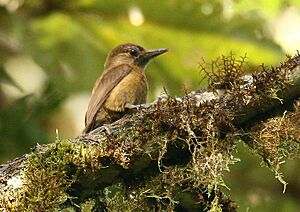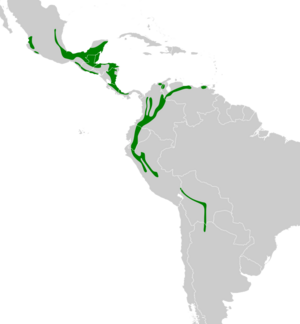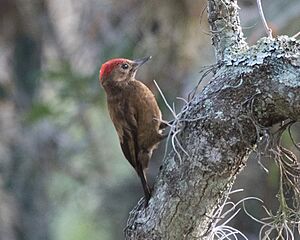Smoky-brown woodpecker facts for kids
Quick facts for kids Smoky-brown woodpecker |
|
|---|---|
 |
|
| Female in NW Ecuador | |
| Conservation status | |
| Scientific classification | |
| Genus: |
Leuconotopicus
|
| Species: |
fumigatus
|
| Subspecies | |
|
see text |
|
 |
|
| Synonyms | |
|
Veniliornis fumigatus |
|
The smoky-brown woodpecker (Leuconotopicus fumigatus) is a type of bird from the woodpecker family. You can find it in many countries, including Argentina, Mexico, Colombia, and Peru. This bird is known for its brownish feathers, which give it its name.
Contents
About the Smoky-Brown Woodpecker's Name
The smoky-brown woodpecker was first described by a French scientist named Alcide d'Orbigny in 1840. He saw these birds in Argentina and Bolivia.
Over time, scientists have changed the group (called a genus) this woodpecker belongs to. It was first called Picus fumigatus, then moved to Leuconotopicus, then Picoides, and now it's back to Leuconotopicus for some groups of scientists. Other groups, like the American Ornithological Society, place it in the genus Dryobates.
The name Leuconotopicus comes from old Greek words. Leukos means white, noton means back, and pikos means woodpecker. The second part of its scientific name, fumigatus, is a Latin word that means "smoked," which describes its brownish color.
There are five different types, or subspecies, of the smoky-brown woodpecker:
- L. f. oleagineus
- L. f. sanguinolentus
- L. f. reichenbachi
- L. f. fumigatus
- L. f. obscuratus
What the Smoky-Brown Woodpecker Looks Like
The smoky-brown woodpecker is about 18 centimeters (7 inches) long. It weighs between 31 and 50 grams (1.1 to 1.8 ounces).
Male and female smoky-brown woodpeckers look very similar, but their heads are different. Males have a red color from their forehead all the way to the back of their neck. Females have a dark brown head, sometimes with a bit of olive green and a few white spots.
Both male and female adults have an olive-brown face. They have a thin white line above their eyes and a black "moustache" stripe. Their bodies are mostly brown or olive-brown, with a reddish tint on their shoulders. Their tail feathers are dark brown. Their belly is olive-brown and sometimes lighter. They have a blackish beak, dark brown eyes, and grayish legs.
Young woodpeckers (juveniles) are a duller, more sooty brown than adults. They don't have the red tint on their back. Young males have a dull red crown, and young females have a dull red forehead.
The different subspecies have slight differences:
- L. f. oleagineus has longer wings and more white around its eyes.
- L. f. sanguinolentus is smaller and a richer brown. It has a paler face and no white around the eye.
- L. f. reichenbachi is similar to sanguinolentus but is a duller brown.
- L. f. obscuratus has the longest wings of all the subspecies. It is darker and more gray-brown.
Where They Live and Their Homes
The smoky-brown woodpecker lives in many different places across Central and South America.
- L. f. oleagineus lives in southwestern and eastern Mexico.
- L. f. sanguinolentus is found from southern Mexico down to western Panama.
- L. f. reichenbachi lives in northern and northeastern Venezuela.
- L. f. fumigatus is found from eastern Panama, through Colombia, and south into Ecuador, Peru, Bolivia, and northwestern Argentina.
- L. f. obscuratus lives in southwestern Ecuador and northwestern Peru.
These woodpeckers like many types of wooded areas. They live in humid forests, cloud forests, dry mountain woodlands, and even coffee farms. They can be found from sea level up to high elevations in the mountains, depending on the country. For example, in Mexico, they live up to 1,500 meters (about 4,900 feet) high. In Colombia and Peru, they are often found between 1,200 and 2,800 meters (about 3,900 to 9,200 feet).
Behavior
Movement
The smoky-brown woodpecker stays in the same area all year long. It does not migrate.
Feeding
Smoky-brown woodpeckers usually look for food alone, in pairs, or with their family. They often join groups of different bird species that are feeding together. Their main food is wood-boring beetles, both adult beetles and their larvae (young). They also eat small amounts of fruit.
They usually search for food in the middle and lower parts of the forest, especially in thick plants and vines. Sometimes, they will feed higher up in the trees. They find most of their food by pecking and hammering on wood.
Reproduction
The breeding season for smoky-brown woodpeckers changes depending on where they live. In Central America, it's from February to June. In Venezuela, it's February and March, and in Colombia, it's from October to April.
Both the male and female woodpeckers dig out a nest hole. They usually make their nest in a dead tree branch or trunk. Sometimes, they even use a fence post. The nest is typically between 1.5 and 8 meters (5 to 26 feet) above the ground. A female woodpecker usually lays four eggs. Scientists don't know much about how long the eggs take to hatch or how long the young birds stay in the nest.
Sounds and Calls
The smoky-brown woodpecker makes many different sounds. Some calls sound like "wick," "chuk," "pwik," or "quip." They also make a high-pitched "keer-keer-keer-keer" sound. When they are interacting with each other, they might make a "queaky, sucking 'wick-a wick-a'" sound. Their drumming sound, which they make by pecking wood, is very fast and long.
Conservation Status
The IUCN (International Union for Conservation of Nature) has listed the smoky-brown woodpecker as a species of "Least Concern." This means it is not currently in danger of disappearing.
This woodpecker lives across a very large area. Scientists estimate there are at least 50,000 adult birds, although this number might be slowly going down. No major threats have been found for this species. It is considered common in some parts of its range and lives in many protected areas. So, it is likely to be safe for now.



